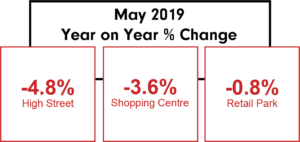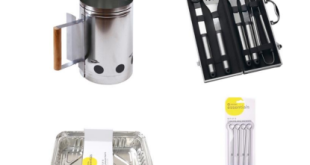 Footfall declined by 3.5% in May, compared with the same month last year when it fell by 0.4%, according to the latest statistics from the British Retail Consortium (BRC)-Springboard.
Footfall declined by 3.5% in May, compared with the same month last year when it fell by 0.4%, according to the latest statistics from the British Retail Consortium (BRC)-Springboard.
Covering the four weeks from 28 April 28 to May 25, the BRC-Springboard Footfall and Vacancies report reveals that on a three-month basis, footfall decreased by 0.7%. The six and 12–month averages are -1.3% and -1.4% respectively.
High Street footfall slumped by 4.8%, following a 0.5% increase in May last year. The three-month average decline is 0.8%.
Retail park footfall slipped by 0.8%, following from a 0.6% rise last May. The three-month average growth is 1.0%.
Shopping centre footfall dropped by 3.6%, following May 2018’s decline of 2.9%. This was steeper than the three-month average decline of 2.1%.
BRC chief executive Helen Dickinson OBE commented: “The UK experienced the worst footfall figures in six years [excluding Easter distortions, caused by the popular Easter shopping period falling in different months in consecutive years], with declines in every region, and across high streets, retail parks and shopping centres.
“This reflects our recent sales data, which showed the largest drop in retail sale on record. The colder weather, as well as ongoing political and economic uncertainty, made many consumers think twice before heading out to the shops this May.
“While consumers stayed away from the shops, retailers still had to pay the full cost of business rates, which are levied regardless of whether a store makes a penny at the till. These rising costs are making many retailers rethink investment decisions, as well as contributing to store closures up and down the country.
“The government must act to reform this anachronistic tax system or it will be the consumers who suffer the shuttered windows at their local shopping locations.”
Springboard marketing and insights director Diane Wehrle added: “The -3.5% drop in footfall in UK bricks-and-mortar destinations in May is a poor result and is consistent with the drop in sales for the month.
“However, we should note the year-on-year comparisons are off the back of a particularly strong result in May last year of -0.4% – which was boosted by warm weather and special events, and followed on from a challenging April marred by bad weather and loss of seasonal sales due to the early March Easter.
“All destination types found it much tougher this May to attract customers, but the fact that the greatest impact was felt by high streets with a drop in footfall of -4.8% is not a surprise given the much poorer weather than in May last year.
“Footfall worsened across all parts of the day, but the most significant drop occurred post-5pm, moving from a rise of +1.9% in May last year to a decline of -4.5% this year. It’s clear that consumers are being ever more discerning in their dining habits, and recent failures in the sector indicate both the level of competition and suggests that dining operators need to provide a more tempting food offer keep customers for the post-5pm spend slot.
“Nonetheless, it’s really important to note the longer term trend, with footfall declining by just -1.1% over the five month period since January. This a much improved position on the drop of -2.4% over the same five month period last year, showing us that the reduction in customers visiting retail destinations this year has slowed, a more positive result than might have been expected.”
 Housewares Business-to-business magazine for housewares retailers and their suppliers
Housewares Business-to-business magazine for housewares retailers and their suppliers



